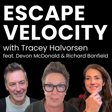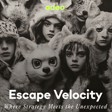
Ashley Budd, Author of Mailed It! 💌 | Senior Marketing Director at Cornell University | Nonprofit Consultant | Keynote Speaker
In this episode of Escape Velocity, host Tracey Halvorsen sits down with Ashley Budd, higher education marketing expert and co-author of Mailed It!, to discuss how email remains one of the most powerful communication tools—when done right.
Ashley shares insights from her book, offering practical strategies and “hacks” for making email more effective in an era of overwhelming digital noise. From the importance of clear subject lines to the role of authenticity, empathy, and logic in building trust, Ashley breaks down the principles that help emails stand out and drive action.
The conversation touches on the evolution of email, how AI and automation are shaping inboxes, and why personalization isn’t just about inserting a name—it’s about delivering real value. Ashley also explains the impact of eye-tracking studies on email design, why institutions should embrace a more engaging and even humorous tone, and how a well-planned content strategy can transform audience engagement.
If you want to make your emails more impactful, reduce unsubscribe rates, and turn your email program into a relationship-building powerhouse, this episode is a must-listen.
🎧 Tune in to Escape Velocity to hear Ashley Budd’s expert take on how to cut through inbox chaos and make email work for you!






